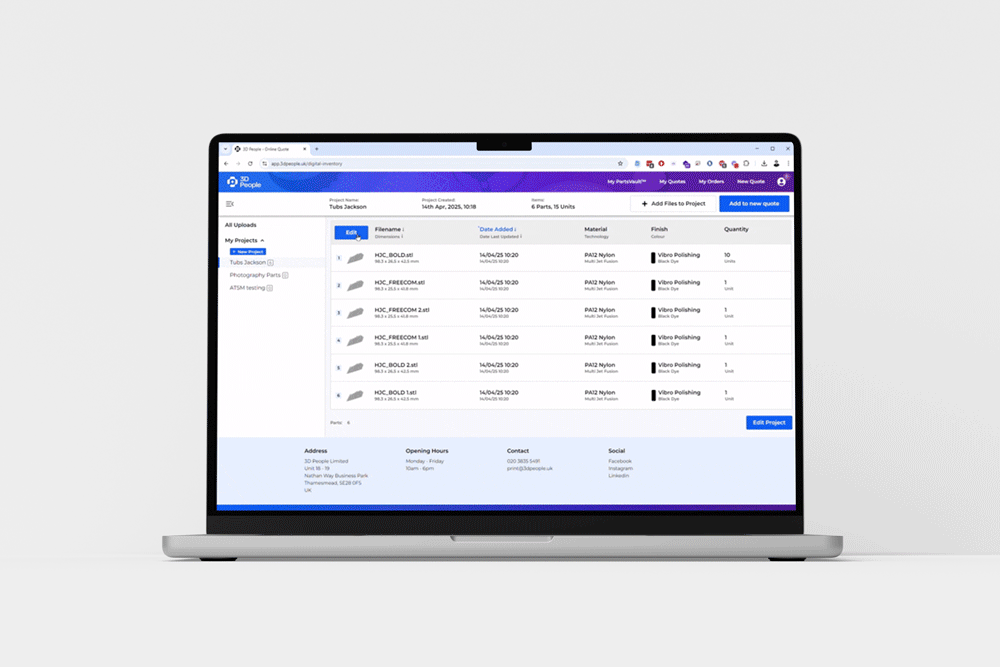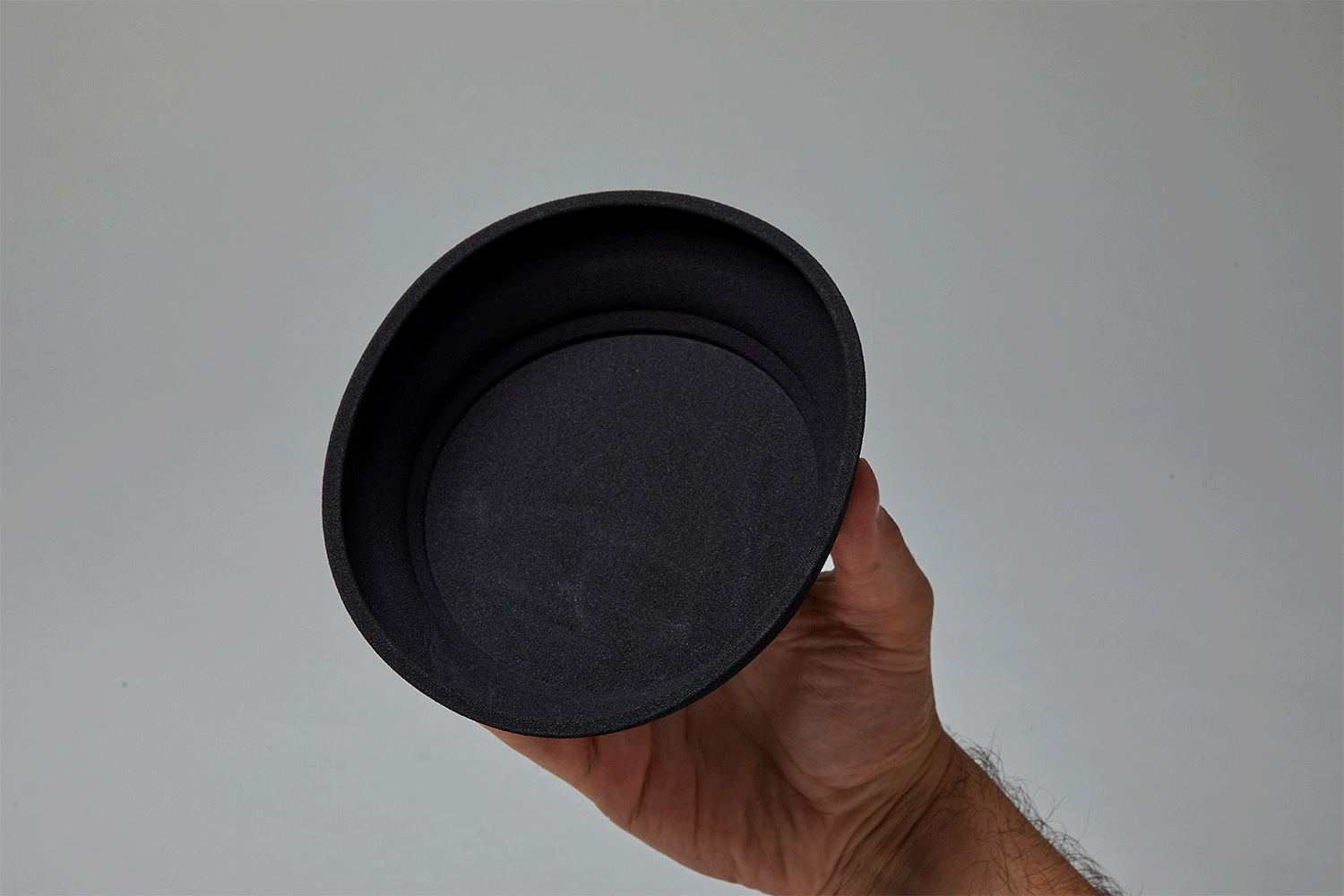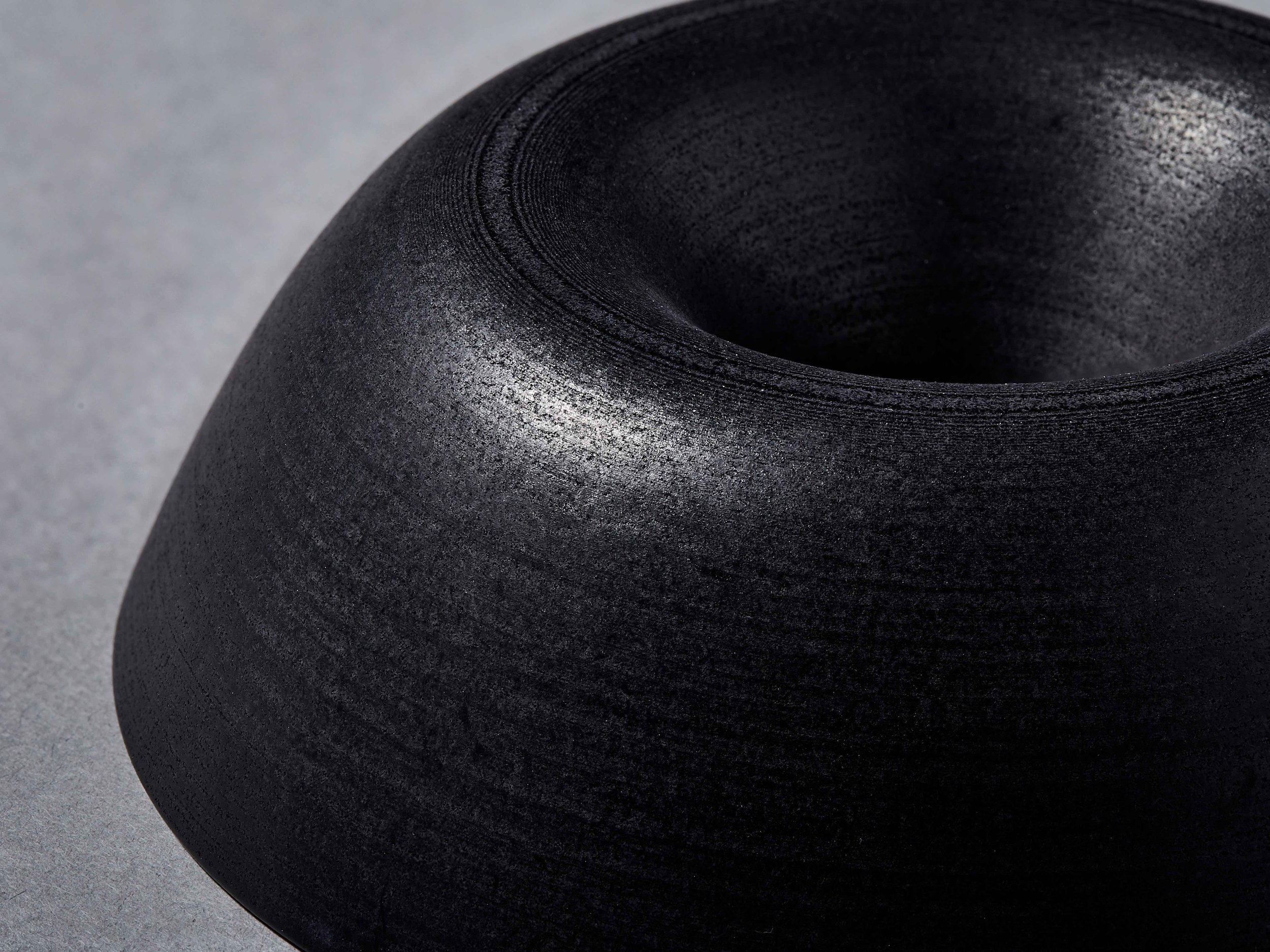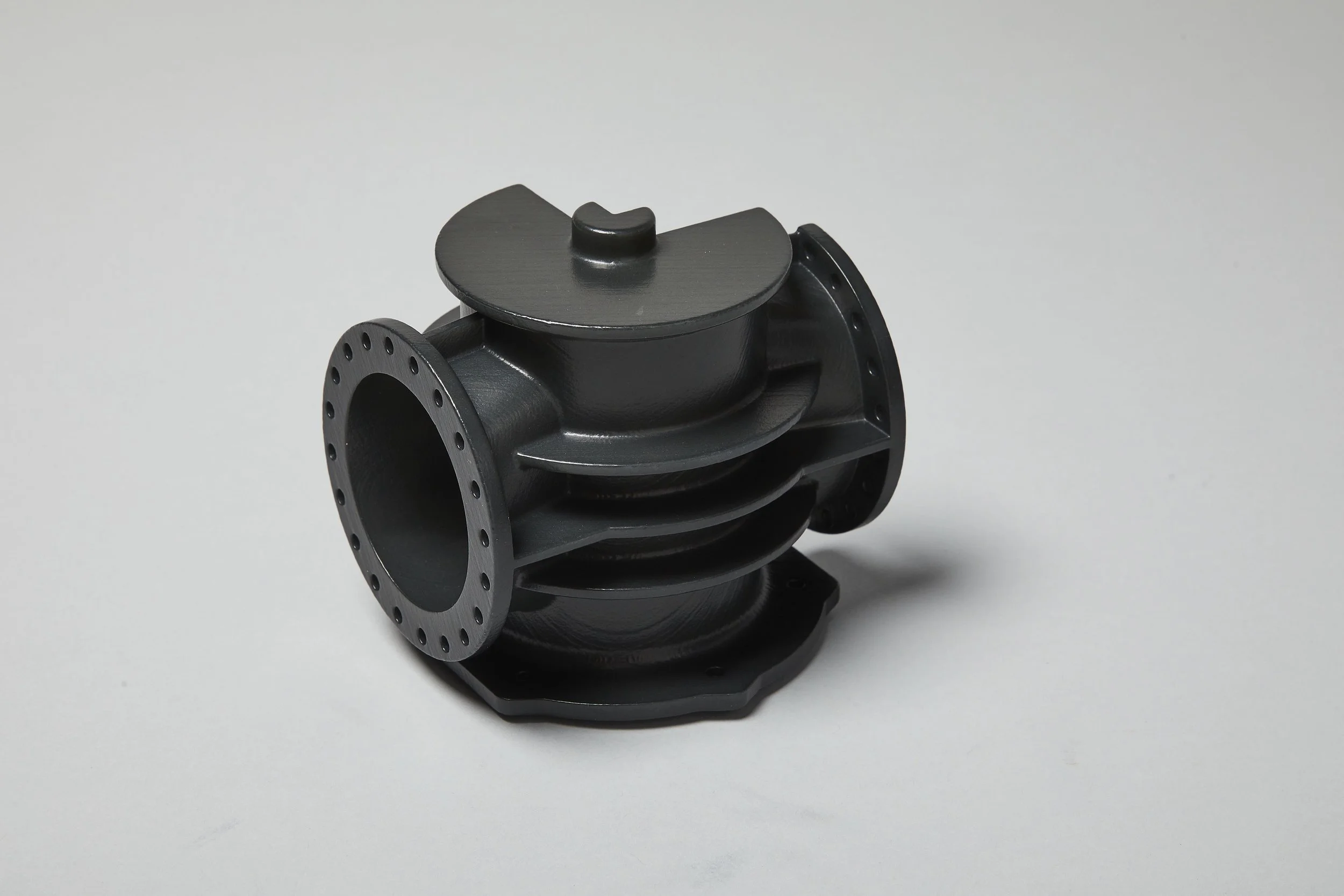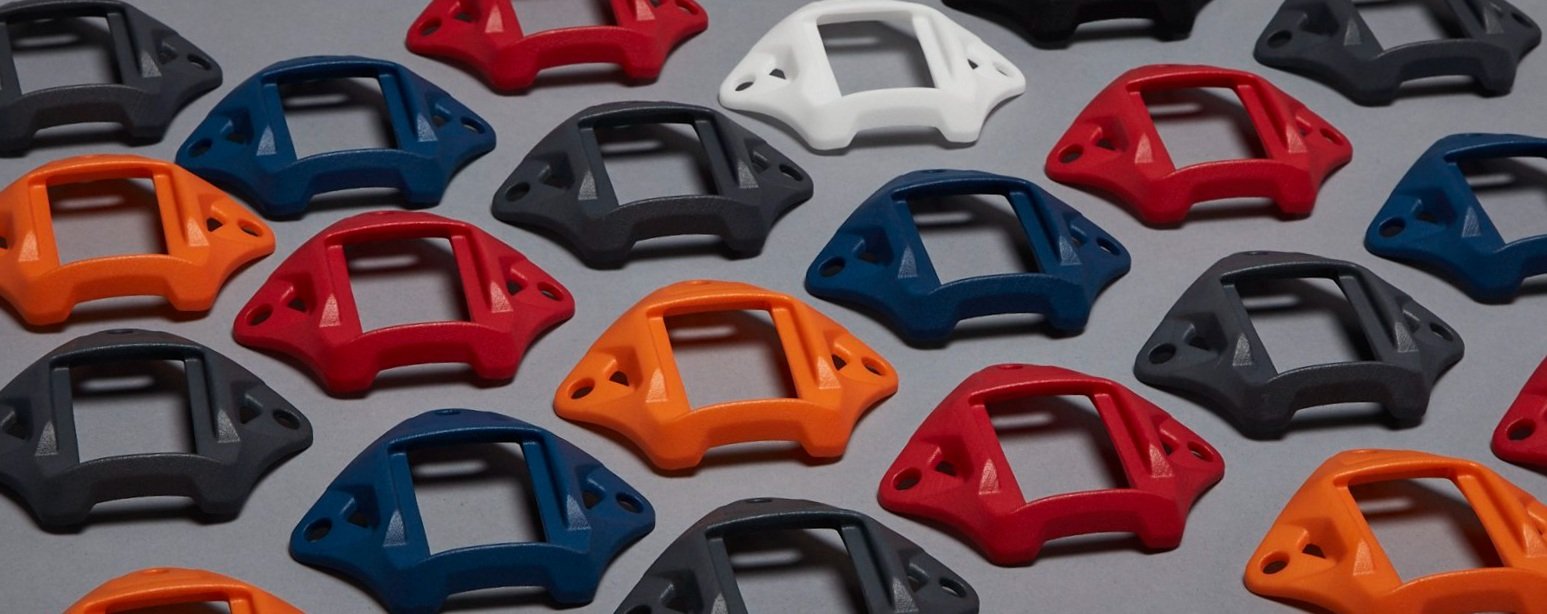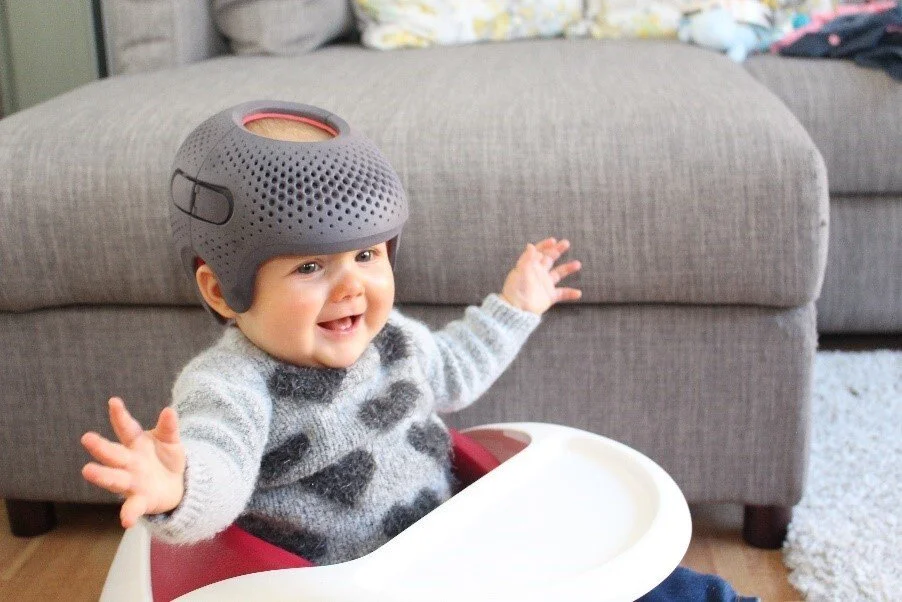Launching PartsVault™ — a smart and secure digital inventory platform. Think of it as your digital parts locker. Whether you're managing repeat production runs, ordering spares, or updating designs, everything is centralised, version-controlled, and connected directly to 3D People's manufacturing capabilities.
End to End Quality Control for AM: What, Why and How
CHAMPIONING ON-DEMAND MANUFACTURING AS INDUSTRIES DEMAND FASTER, MORE FLEXIBLE PRODUCTION
THE CRITICAL IMPORTANCE OF POST-PROCESSING IN AM
While AM has revolutionised part design, enabling complex geometries and rapid iteration, the raw outputs from even the most advanced AM technologies often still fall short of industry requirements. Parts often emerge from the build chamber with surface roughness, inconsistent mechanical properties, and residual powder or support structures that must be removed or refined before parts can be put to use. While AM enables direct part production, many industries require additional finishing steps to meet specific functional and aesthetic standards. The misconception that AM produces a final-use product in a single step has hindered its adoption, as companies often underestimate the necessity of thorough post-processing techniques to bring parts up to industry standards.
CHAMPIONING NEXT-LEVEL POST-PROCESSING FOR FLAWLESS ADDITIVE MANUFACTURING
With additive manufacturing, one often-overlooked factor separates cutting-edge from cut-rate — surface finish. As manufacturers push AM to production-grade levels, 3D People, a leading UK-based subcontract 3D printing bureau, is taking a stand on why surface finish is the real game-changer in AM for production applications.
POST-PROCESSING & THE VALUE OF HIGH-QUALITY FINISHING
The conversation around additive manufacturing (AM) has matured. No longer is the fascination solely about how we build parts, it’s about how we make them fit for purpose. For AM to stand alongside traditional manufacturing as a viable production technology, post-processing and high-quality finishing must be considered as part of the process
CASE STUDY: 3D People 3D Printing with Zeal
Zeal Lifestyle is a sustainable lifestyle company, based in Surrey, UK; with a specific focus on stylish and highly functional and adaptable mobility aids for supported living.
The Zeal journey began when its two founders — Georgia Williams and Joshua King — independently looked into purchasing a walker for family members. Before that, though, both Georgia and Josh studied industrial design at Brunel University in London. Georgia going on to work for renowned fashion brand Dior for a number of years, while Josh garnered experience working as an industrial designer for Seymour Powell and Factory Design.
During the Covid pandemic lockdowns, Georgia’s Great Aunt, at 86 years old, needed a walker to use both indoors and outdoors to support her mobility. Despite Georgia searching for hours and hours, she could not find a stylish walker that suited her Great aunt’s stylish tastes and personality. Resistance to using mobility aids is a common obstacle for family members both in terms of denial that it is needed, but also the resentment of having to purchase a device that often looks and feels limited and unappealing.
This is what inspired Zeal Lifestyle, Georgia and Josh decided to take this matter into their own hands and design a walker putting the end user first. At the end of last year, Zeal opened for pre-orders having earned global recognition and awards for its user-centred design, including the Unlocking Potential Award by Innovate UK. The full and official launch, which will include delivery of pre-orders and opening up for direct retail options to purchase, is scheduled for Summer 2025.
The Zeal walker is coming to market following four years of collaboration with users and a comprehensive product development process, that is completely in line with what would be expected for a Class 1 medical device that has to adhere to specific ISO standards.
Zeal’s mission is to remove the stigma of walkers and mobility aids, and provide a product that users are proud to be seen with. The emotions involved in accepting the need for and purchasing a mobility aid should not be underestimated. A walker that offers elegant style and comfort, as well as being lightweight and easy to handle goes a long way towards overcoming any emotional resistance. This is the ethos behind Zeal and it shows.
However, bringing that ethos into the real world is neither quick nor easy. The product development process, by necessity for a class 1 medical device, is exacting and challenging. Safety and efficiency of the device are vital, while incorporating the essence of Zeal’s style and comfort. In addition, sustainability has also been a very important element of Zeal’s development and as a result of that commitment, the Zeal walker has been fully designed for disassembly.
For the prototyping of Zeal’s plastic parts, the Zeal team worked with 3D People. The development of the Zeal mobility aid was complex and required numerous series of functional prototypes during the iterative process that had to meet demanding requirements. The first fully functional Zeal walker prototype was made with 3D printed parts for testing size and human interactions. Utilising the Selective Laser Sintering (SLS) and MultiJet Fusion (MJF) processes offered by 3D People, along with their finishing options ensured Zeal received the high-quality parts they required reliably and fast. According to Josh: “Over the past year, we’ve ordered around 500 parts in SLS and MJF for various prototypes and design iterations. The MJF process is great for parts that need to be smooth and after post-processing, it’s hard to tell them apart from injection-moulded parts. SLS works better for visual parts since the off-white finish is more aesthetically pleasing than MJF’s dark grey. We switch between the two different processes depending on the stage of design. Costs are also important, of course, and these can also vary based on part size and process used, so that’s something we factor in too, but it’s an easy thing.”
It's hard to overstate how important quality is for functional prototypes that have to go through stringent testing. Josh continued: “The quality of the parts from 3D People has been consistently excellent. Everything we’ve received has been accurate, and there’s been very little need for extra finishing before testing. Any issues we have had were sorted quickly by the team, which has made the whole process much easier.”
When finishing of parts was required, 3D People offer multiple options including dedicated vapour smoothing, vibro-polishing and dyeing. The company also stands out for its creative approach to finishing and working with clients to get the finish they want. For the Zeal, Josh found the vapour smoothing option invaluable for a number of parts and for different reasons. He said: “Vapour smoothing gives the parts a polished look and makes them feel nicer. It also saves us from having to do extra finishing work later, which has been a big time-saver. Vapour smoothing can also give a more waterproof finish which is easy to wipe clean which was really useful for us because unfinished parts get dirty really quickly and easily, which is not ideal when undertaking multiple user tests.”
Pre-orders for the Zeal walker have exceeded expectations, according to Georgia and the company is working hard to fulfil them all ahead of the summer launch.
ARTICLE: Automation is Unlocking the Future of AM Services
CASE STUDY: Tides Studios’ Shades of Identity Produced on Demand by 3D People
Additive manufacturing (AM) technologies have proved time and again that they are capable of making things and making things better. This has proven true once again with the polymer powder bed fusion (PBF) AM process for the production of stylish and original eyewear.
As a case in point, Tides Studios, based in London, has built a successful business by focusing on eyewear, specifically sunglasses, utilising polymer PBF AM and some key finishing techniques alongside a made in London business model that contributes to its sustainability goals.
Founded by Joseph Alpert, Tides Studios is a sustainable design company that originally focused on make-up and brand packaging, until it expanded into eyewear and launched its own brands and full collection of sunglasses. It also produces bespoke, made-to-order sunglasses, or ‘Shades of Identity.’
The premise that the studio adheres to is that “sunglasses go beyond their practical role of sun protection; they tap into human desires for privacy, mystery, and control over perception. Ultimately eyewear has been a large part of popular culture from the stage to dancers in the crowd and we want to be part of that evolving story.”
For Tides Studios this evolution goes even further beyond the practicalities and the style – to the means of manufacture. Eyewear is not a unique application for AM in 2025, but unique is absolutely a word that can be attributed to the Tides Studios collection as well as commissioned, bespoke sunglasses for customers that are fully enabled by additive technologies and an ecosystem of efficient finishing technologies.
According to Joseph: “The nature of additive technologies is a key enabler for how we design and empowers us to experiment freely, pushing boundaries to create eyewear that fits a diverse range of styles, faces, and preferences. Thus, for us, and many of our customers, eyewear isn’t just an accessory—it’s a platform for self-expression, reflecting both cutting-edge technology and the individuality of its wearer.”
Joseph and his team had been watching the maturation of AM technologies for a number of years and utilising them frequently for product development work. The ideas for the sunglasses had materialised 2-3 years ago, in collaboration with a fashion brand La Maskarade, but the early prototypes were heavy and not user-friendly in the slightest. The idea to use 3D printing technologies to hollow out the heavy frames was posited and tested, with functional prototype runs that resulted in the first model for the studio.
Subsequently, Tides launched the first models and garnered “a ton of interest,” according to Joseph. “It really blew up and exceeded our greatest expectations and we transitioned to an eyewear business full time about a year ago.”
The business is fully enabled by 3D printing, with Joseph’s convictions that additive technology, specifically PBF, could produce Tides original designs paying off. “Although, it wouldn’t have happened without an old man in engineering collaborating with young people in fashion,” he quipped. The development phase took time too, and Joseph and his team worked with 3D People during this time.
“We did send prototypes out to other AM bureaux early on, and there were some good results with the prints themselves. What sold us on 3D People, though, was how accommodating they were to our vision, and finding solutions that would allow us to develop the collection and move into production with them. While the PBF production process is vital, we needed more. Specifically in terms of bespoke colour options and a superior finish to every pair of glasses.”
Polymer PBF AM processes offer the best strength and flexibility for eyewear as well as enabling complex, unique and intricate designs that can be produced cost-effectively. However, finishing PBF parts that come off the machine is an essential post processing step for any application that is going to be touching the skin. PBF parts tend to have a sand-papery feel to them and can be rough, especially on the sensitive skin around the face. Smoothing and strengthening the surface finish is a must.
Indeed, 3D People were able to offer Tides Studios a unique finish solution to meet their needs in a cost-effective way. They were able to combine their in-house vibro polishing and vapour smoothing capabilities to achieve the ultimate finish. This, along with the broadest palette of colour dye options in the UK gave Tides exactly what they needed. As a result, 3D People are now completing batch production runs for Tides Studios every month, up to 500 items each time.
Felix Manley, Co-Founder of 3D People commented: “Working with Joseph and the Tides team has really cemented for us how important finishing options are for production applications of additive techs like MJF and SLS, which we run in-house at our facility in London. It is why we place as much emphasis on finishing systems as we do on the 3D printing systems. By focusing on the application, we are able to deliver the best possible finishing results, which, when you look at the Tides Sunglasses, speak for themselves.”
The London connection is an important one. All of Tides Studios sunglasses are sourced and made locally in London. This is with the single exception of the lens base, with the only factory to manufacture them based in China. However, that is sourced raw and is then cut and assembled at Tides’ Whitechapel operations. As Joseph commented: “‘Made in London’ isn’t just a label—it’s a commitment to sustainability, authenticity, and accountability in every pair of glasses we create.”
Tides Studios designs and makes sunglasses for customers from all over the world, and this includes for some recognisable names such as Beyonce for her Renaissance tour, and British stylist, Betsy Johnson.
The full collection can be viewed here.
Raising the Bar for Additive Manufacturing with Expert Service & Delivery — Beyond the Status Quo
The business of manufacturing continues as it always has, and typically brings successes and challenges across the workflow. The evolution of how manufacturers produce and deliver their applications is a particularly interesting factor to consider as the number of manufacturing processes available and their capabilities increase and improve. One of the more disruptive technologies to emerge in recent decades is that of additive manufacturing (AM) or industrial 3D printing. This technology set itself incorporates a range of processes, a continually growing palette of materials, and software that enables the technology and improves efficiencies. Utilising industrial 3D printing for any manufacturing discipline, whether for rapid prototyping, tooling, or, increasingly, production on demand, does not come without its own set of challenges, but deploying AM can also bring great advantages.
The benefits of AM are well documented, in essence allowing manufacturers to exploit the ability to build complex parts, in one piece, which were previously impossible. This in turn enables the consolidation of existing parts, reducing assembly requirements and reducing overall costs. In addition, with explicit design for process knowledge, AM parts can also be made stronger and lighter making them more efficient across their life cycle while also reducing material consumption. For low and medium production runs, AM can eliminate the need for tooling, making it a faster and more cost-effective manufacturing option. These advantages mean that AM has become a viable option for many manufacturers.
However, while all of these advantages are enabled by the additive systems that build the parts, in reality, the AM hardware is actually just one piece — albeit a vital piece — of an ecosystem of technologies that enable success with AM.
The building of the parts utilising AM is the essential core of the manufacturing workflow, however what happens before and after the build are also vital to delivering high quality parts in the most efficient and cost-effective way.
Here, we are exploring how a specialised bureau can raise the bar for AM with quality services that extend beyond just the 3D printed parts themselves.
A Holistic Approach to Delivering Quality
Experience and expertise go a long way to alleviating the challenges manufacturers face when using AM. Working with a specialist AM bureau ensures that both come as part of the service from beginning to end. Look for an innovative business model that delivers high quality end-to-end processes including fast, automated ordering and tracking at the beginning and dedicated post-processing and finishing capabilities at the end.
Automated Ordering at the Front End
Automation is a technology area that has also progressed significantly in the last decade. A forward-looking AM service bureau will have grasped this opportunity to develop and embed enhanced efficiencies into its ordering system to improve user experience. A dedicated automated ordering system will greatly streamline the ordering process, allowing clients to place their orders quickly and intuitively, while also providing full tracking capabilities.
An intuitive automated ordering platform should enable customers to upload their files, select material/s, and specify finishes with ease. It should then be able to provide immediate pricing feedback based on material cost, print time, and complexity. Once the order is confirmed, the system can then provide status updates of all orders in real-time, greatly improving transparency and communication.
By leveraging technology to automate ordering, AM service providers enhance customer satisfaction and operational efficiency, making AM more accessible and speeding up the front end of the workflow significantly.
Dedicated Post-Processing Services at the Back End
While we’ve established that the printing process is pivotal, the finish of the parts that come off the AM system often determines its quality and, importantly, its usability. Dedicated post-processing services are also essential for ensuring that 3D printed parts meet client expectations.
It’s probably important to note here, that post-processing is actually an umbrella term for a number of stages that AM parts may need to go through after they come out of the AM system and before they are fit for purpose. This is especially true for powder bed fusion (PBF) AM processes. The term “post-processing” is often used interchangeably with “finishing”, which is somewhat of a misnomer. With any PBF process there are a series of essential post-processing steps that are non-negotiable and must be undertaken prior to the AM-produced part finishing stages, which are optional. Thus “finishing” is actually an important subset of post-processing, not a term that should be used interchangeably with it.
Post-processing for PBF parts typically involves:
• Depowdering / excess material removal
• Cleaning
Of note for polymer PBF processes, support removal is typically not required as the powder bed acts as the support system. Neither are heat treatments to cure the materials.
Finishing of parts can include any or all of the following to improve the aesthetics of the surface finish and, for some applications, the mechanical properties of the part:
• Surface finishing
- Vibro polishing
- Vapour Smoothing
- Bead blasting
- Sand blasting / Sanding
• Machining
• Colouring (Dyeing / Painting)
• Plating
• Inspection.
For AM production applications, finishing of parts is often a considerable, but overlooked, section of the workflow that can significantly impact the overall cost-per-part and project timelines. This is especially true if the final part characteristics need to be enhanced in terms of functionality and/or aesthetics.
Investing in dedicated finishing capabilities allows an AM service provider to offer a superior product quality, which is vital for industries where precision and aesthetics matter significantly.
Quality finishing, quite simply, differentiates an exceptional part from an average one. Any AM bureau that prioritises high-quality finishing can cater to specific client requirements, under one roof, to raise the bar for AM parts.
To Sum Up
Any business looking to utilise the services of an AM bureau should identify one that is committed to the highest quality 3D printed parts but that also understands how to add value before, during, and after the build. The team at 3D People continues to deliver parts in this way to a growing constituency of clients that recognise their expertise in these areas. We welcome any questions — or, indeed, any challenging applications — from anyone that wants to know more.
3D PEOPLE INTRODUCES TPU01 MATERIAL FOR AM PARTS SERVICE
(London, UK. 7 November, 2024.) 3D People, a leading additive manufacturing (AM) service provider of high-quality 3D printed parts on demand, is pleased to announce that it has added a new material to its service offering, namely Ultrasint TPU01.
According to Felix Manley, Co-Founder of 3D People: “Flexibility is the key to the TPU01 material, and in more than one way. The material itself is the most advanced elastomeric material, developed specifically for the MultiJet Fusion (MJF) AM system from HP, and as a result it produces the highest quality, flexible parts. Introducing this material also provides more flexibility for our customers, a significant number of whom have been asking for it. Now they can get their PA12 Nylon and TPU parts from the same partner, with quality assured.”
3D People has years of experience running MJF technology and all of the company’s technicians have completed HP’s comprehensive “Train to Maintain” program. This specialised training has instilled a deep understanding of the machines, ensuring optimised performance, enhanced reliability, and consistent delivery of high-quality results with MJF parts. The TPU01 material is a perfect addition to the 3D People service offering with its exceptional suitability for end-use parts for a variety of applications where performance and durability are essential.
This is especially true considering TPU01 has been developed for the MJF AM process. Sasha Bruml, Co-founder of 3D People explains: “It is well known, that one of the headline benefits of AM is the ability to produce complex geometries — such as lattices — efficiently and cost-effectively. Combine that capability with this material and we are able to offer a distinct advantage for our customers who are looking to fine-tune the hardness, flexibility, and shock absorption of their applications. We are seeing some highly customisable solutions that outperform traditional elastomeric materials as a result. It’s exciting.”
A further key advantage of TPU01 parts produced by 3D People is the ability to achieve significantly advanced finishes. Unlike other elastomeric materials used in additive manufacturing that often face challenges when attempting smooth finishing, the TPU01 material is uniquely compatible with vapour smoothing processes. The benefits of this extend well beyond the aesthetics of the finish, because applying vapour smoothing to TPU01 AM parts also significantly enhances its properties — increasing water tightness and reducing the likelihood of crack initiation. This results in part performance that is closer to that of moulded polyurethane parts.
There are also favourable cost implications with this new material because the MJF process typically offers more competitive pricing than SLS. With this in mind, 3D People are able to produce and supply TPU01 parts at a cost comparable to PA12 MJF, making batch production more efficient and cost-effective for clients.
The 3D People team has allocated a dedicated TPU01 schedule on its in-house MJF machines. This is to align with customer demand and allows the company to offer this flexible material with rapid turnaround times without compromising on quality. The team believe that they are now able to provide the fastest turnaround TPU printing service in the UK.
Finally, 3D People has developed detailed design guidelines to support customers to get the most out of TPU01. From refining lattice structures to enhancing durability and flexibility, the guidelines have been produced by the company’s expert team and offer guidance to ensure optimal results, whether that is for improving shock absorption or achieving smoother finishes.
ENDS
A Closer Look at Our Colour Options
3D People Offers Broadest Spectrum of Colours with its AM Part Finishing Service
Decoding 3D Printing Files: .step, .stl, and .3mf Explained
UPDATE: Online Quote App now available on mobile
Mount Packaging uses Additive Manufacturing for bespoke packaging machinery integration
UPDATE: 3D People Discontinue FDM Service
UPDATE: Online Quote App now accepts payment terms and more
Streamline your processes with our updated 3D printing quote tool! As a design and engineering expert, you know efficiency is key. Our tool now offers quicker quotes, better management, and smoother ordering of additive manufacturing. Say goodbye to bugs and slow loading times, as we've improved accuracy and speed by 10%. You'll love the small improvements, like the 'apply to all' feature for faster quote specifications, freeing up your time to focus on what you do best.
Additive Manufacturing and Lead Times: How They Impact Each Other
Lead time is a critical factor that must be considered when evaluating the use of 3D printing. In this blog post, we will examine the ways in which 3D printing can reduce lead times in certain situations and the limitations that must be taken into account by engineers seeking to utilise this technology.


